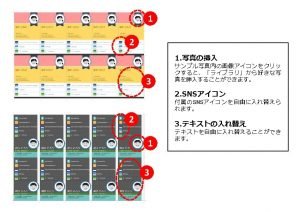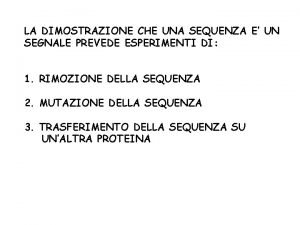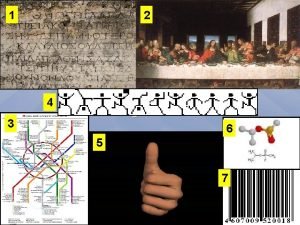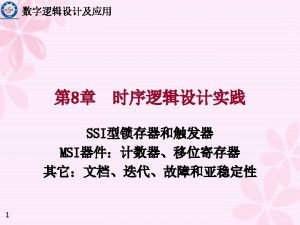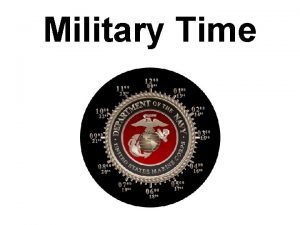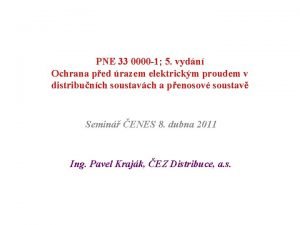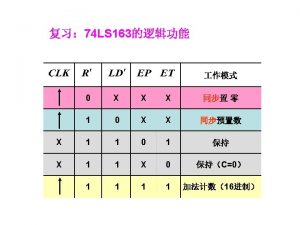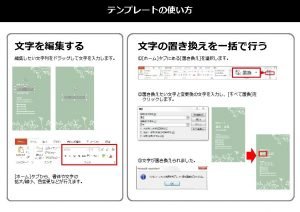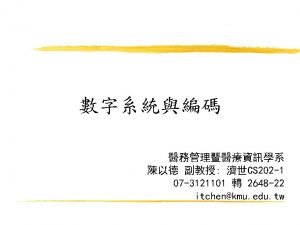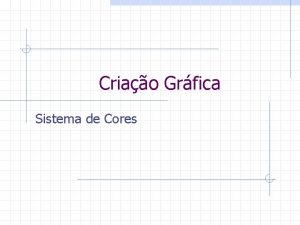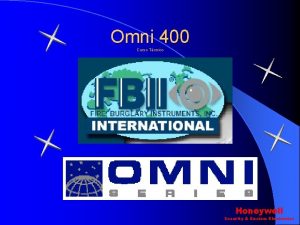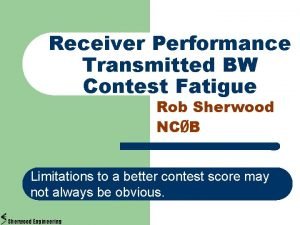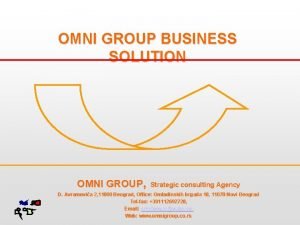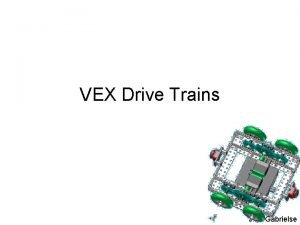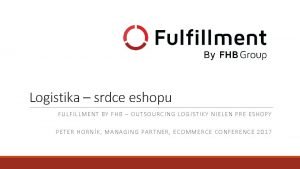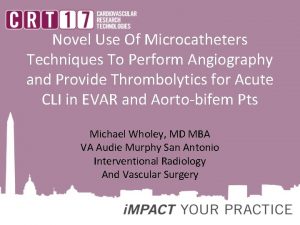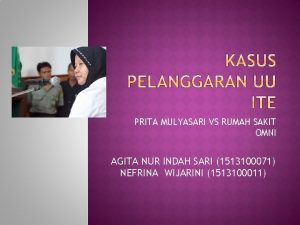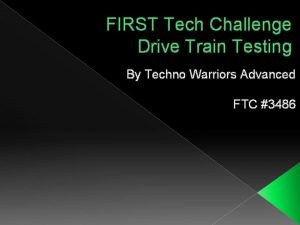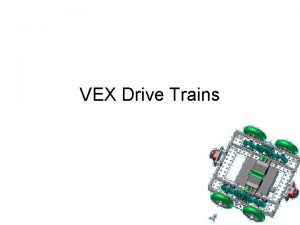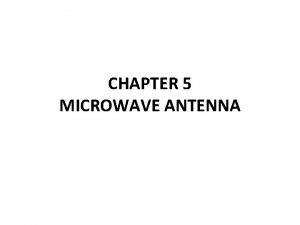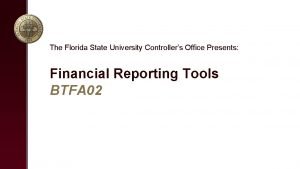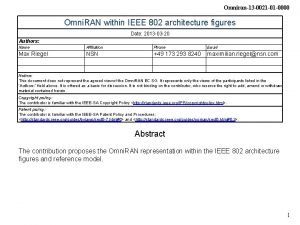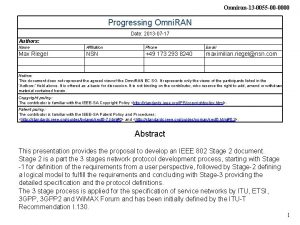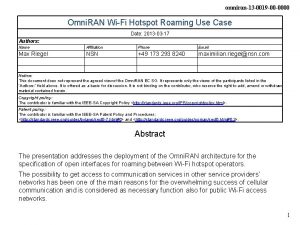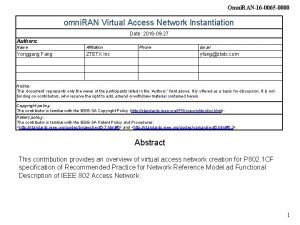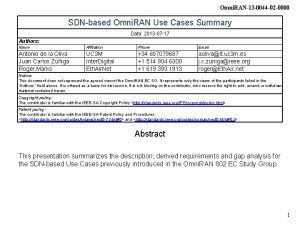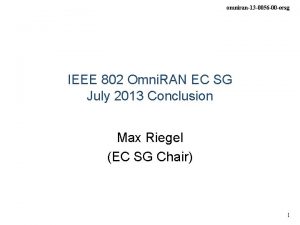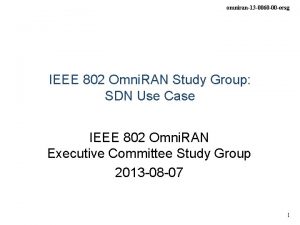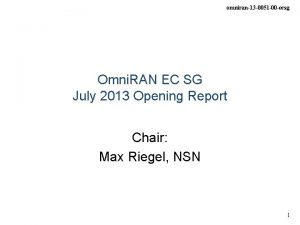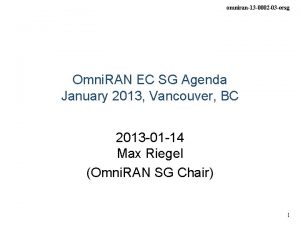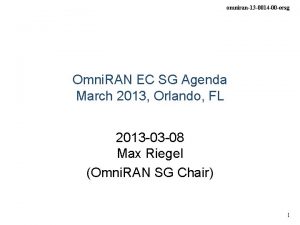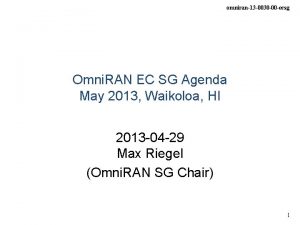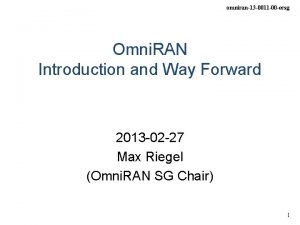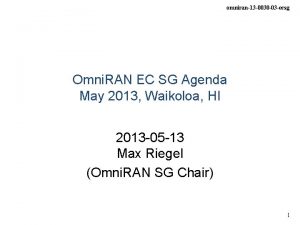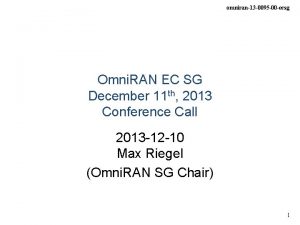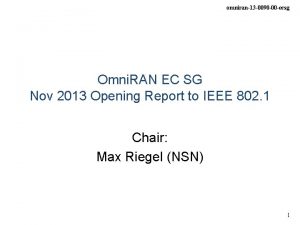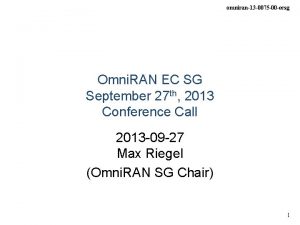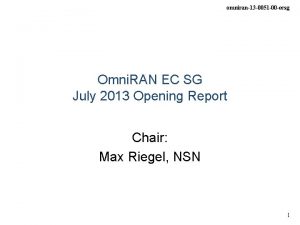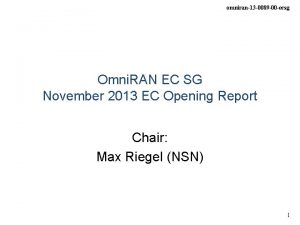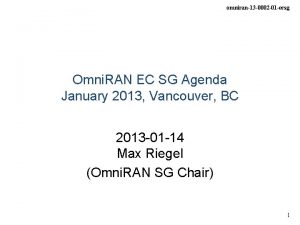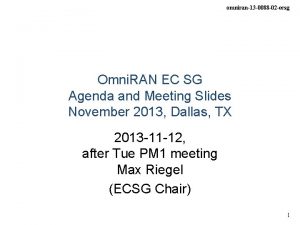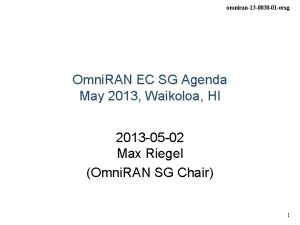omniran13 0100 00 0000 IEEE 802 Omni RAN











































- Slides: 43

omniran-13 -0100 -00 -0000 IEEE 802 Omni. RAN ECSG Results and Proposals Date: 2013 -12 -19 Authors: Name Affiliation Phone Email Max Riegel Juan Carlos Zuniga NSN Interdigital +49 173 293 8240 +1 (514) 904 6300 maximilian. riegel@nsn. com j. c. zuniga@ieee. org Notice: This document does not represent the agreed view of the Omni. RAN EC SG. It represents only the views of the participants listed in the ‘Authors: ’ field above. It is offered as a basis for discussion. It is not binding on the contributor, who reserve the right to add, amend or withdraw material contained herein. Copyright policy: The contributor is familiar with the IEEE-SA Copyright Policy <http: //standards. ieee. org/IPR/copyrightpolicy. html>. Patent policy: The contributor is familiar with the IEEE-SA Patent Policy and Procedures: <http: //standards. ieee. org/guides/bylaws/sect 6 -7. html#6> and <http: //standards. ieee. org/guides/opman/sect 6. html#6. 3>. Abstract Omni. RAN (Open Mobile Network Interface for omni-Range Access Networks) ECSG considered commonalities of access networks based on IEEE 802 technologies to foster interoperability and integration into common control infrastructures. Networking functions and protocol attributes of the PHY and DLL layers belong to the scope of IEEE 802. Based on a few sample use cases, applicability of the approach was determined resulting in questings regards gaps in the existing IEEE 802 specifications. While addressing the potential gaps belongs to the existing IEEE 802 WGs, Omni. RAN ECSG successfully proposed a P 802. 1 CF PAR on Recommended Practice on Network Reference Model and Functional Description of IEEE 802 Access Network. 1

omniran-13 -0100 -00 -0000 IEEE 802 Omni. RAN ECSG Results and Proposals Scope of IEEE 802, gaps and proposed ways forward 2

omniran-13 -0100 -00 -0000 To. C • Motivation • Omni. RAN within the scope of IEEE 802 – Definition of IEEE 802 specific control attributes • Common Network Reference Model • Potential gaps to existing IEEE 802 standards – Investigated use cases • 3 GPP Trusted WLAN Access to EPC (3 GPP Sa. MOG Rel 11) • Zig. Bee Smart Energy Profile 2 (Zig. Bee SEP 2) • Software Defined Networking (SDN) • Necessary specification work within IEEE 802 • Conclusion 3

omniran-13 -0100 -00 -0000 IEEE 802 Omni. RAN Results and Proposals MOTIVATION 4

omniran-13 -0100 -00 -0000 There is Evidence to consider Commonalities of IEEE 802 Access Networks • More (huge) networks are coming up by everything gets connected – e. g. Smart. Grid, ITS, Io. T, … • New markets for IEEE 802 access technologies – e. g. factory automation, in-car communication, home automation, … • IEEE 802 access is becoming more heterogeneous – multiple network interfaces • e. g. IEEE 802. 3, IEEE 802. 11, IEEE 802. 15… – multiple access network topologies 802. 16 802. 11 802. 15 • e. g. IEEE 802. 11 in residential, corporate and public – multiple network subscriptions • e. g. multiple subscriptions for same interface • New emerging techniques, like SDN and virtualization 5

omniran-13 -0100 -00 -0000 IEEE 802 Omni. RAN Results and Proposals OMNIRAN WITHIN THE SCOPE OF IEEE 802 6

omniran-13 -0100 -00 -0000 Access Network Abstraction by Omni. RAN Terminal Omni. RAN Network Reference Model R 2 Ctrl Access Network Terminal Service Ctrl Access Network R 3 R 1 Omni. RAN provides a generic model of an access network based on IEEE 802 technologies Applicati on Transport Network Data Link Physical Medium Scope of IEEE 802 Data Link Physica l Data Link Physic al Medium Networ rk k Data Link Physica Physic al l Applicati on Transport Network Data Link Physical Medium 7

omniran-13 -0100 -00 -0000 Access networks are for dynamic attachment of terminals to networks Terminal Access Network Control Services Internet • Communication networks supporting dynamic attachment of terminals are usually structured into – Access Network • Distributed infrastructure for aggregation of multiple network access interfaces into a common interface – Control (Core) • Infrastructure for control and management of network access and end-to -end IP connectivity – Services • Infrastructure for providing services over IP connectivity 8

omniran-13 -0100 -00 -0000 Functional decomposition of dynamic network access Access Network Control (Core) • Network advertisement • Pre-association signaling • Authentication, authorization and accounting client • L 2 session establishment • Subscription management • Terminal provisioning • Authentication, authorization and accounting server • IP address management • IP connectivity establishment to Internet and services • Policy & Qo. S management server (policy decision) • Mobility Anchor • Roaming support to other cores – w/ Qo. S and Policy Enforcement • L 2 mobility management inside access networks • Traffic forwarding to core based on L 2 addresses 9

omniran-13 -0100 -00 -0000 Access Network Control Plane Functions Access Network Scanning ANQP AAA DHCP Policy Configuration Application Network Selection Association Authentication Authorization Accounting Host Configuration Application Policy Control Application Host Config Release Disassociation Accounting Legend: L 2 Protocol L 2 Attributes L 2 Protocol L 3+ Attributes L 3+ Protocol L 2 Attributes L 3+ Protocol L 3+ Attributes 10

omniran-13 -0100 -00 -0000 IEEE 802 Access Network Functions Access Network L 2 Configuration AAA ANQP Policy DHCP Application Network Discovery Selection Association pe Authentication Authorization Datapath Establishment co Accounting fs Host Configuration to Application Ou Policy Control Datapath Relocation Application Host Configuration Release Datapath Teardown Disassociation Accounting Access Technology Control I/f 11

omniran-13 -0100 -00 -0000 Mapping of Omni. RAN Reference Points to IEEE 802 Reference Model Higher Layers Control R 2 Data Link Physical R 1 Medium Higher Layers Control R 3 Data Link Physical Medium Data Link Physical Medium Current scope of IEEE 802 • Reference Points can be mapped onto the IEEE 802 Reference Model – R 1 represents the PHY and MAC layer functions between terminal and base station • Completely covered by IEEE 802 specifications – R 2 represents the L 2 control protocol functions between terminal and central entities for control and AAA. – R 3 represents the L 1 & L 2 control interface from a central control entity into the network elements • ‘R 2’ and ‘R 3’ cover IEEE 802 specific attributes – However IP based protocols are used to carry control information between network elements and access network control – Effectively each of IEEE 802 network elements contains an IP communication stack on top of the IEEE 802 data path for the exchange of the control information. 12

omniran-13 -0100 -00 -0000 Handling IEEE 802 Attributes in IP Protocols • Current handling of IEEE 802 specific attributes for IP protocols: – IEEE 802 has an established procedure for defining the MIBs of the own technologies • Now completely in scope for IEEE 802 – Currently IEEE 802 does not deal with other IEEE 802 attribute definitions for IP protocols • e. g. IEEE 802 specific AAA (RADIUS, DIAMETER) attributes are done by IETF with only some informal review by IEEE 802 WGs • Specification of IEEE 802 related attributes for IP protocols by IETF has cumbersome issues, e. g. : – delayed availability (completion of RFC may last 2 years after completion of IEEE standard) – RFC’s can’t cope with revisions and life cycle of IEEE standards • new RFC required for each amendment and revision of IEEE 802 standard • new RFC’s have different numbers • RFCs stay forever, while IEEE 802 standards have limited lifecycle • IEEE 802 should take full responsibility for all its IEEE 802 specific attributes for IP protocols – like done today for managed objects (MIBs) 13

omniran-13 -0100 -00 -0000 IEEE 802 Omni. RAN Results and Proposals COMMON NETWORK REFERENCE MODEL 14

omniran-13 -0100 -00 -0000 Make IEEE 802 technologies properly supporting important deployments • IEEE 802 technologies should fulfill the requirements of important deployments, e. g. : – Telecommunication, Smart Grid, ITS, SDN, … • Two main questions have to addressed: – Which IEEE 802 standards do contribute to the particular deployments? – Do the IEEE 802 standards provide all required functions? • A common model is necessary to make IEEE 802 technologies assessable and comparable, e. g. – a reference model to compare functionalities – a reference architecture to show the IEEE 802 standards are fitting together for particular deployments • Omni. RAN defines a Network Reference Model which – maps IEEE 802 technologies into a generic network architecture, – allows functional evaluation of IEEE 802 access technologies. 15

omniran-13 -0100 -00 -0000 Reference Model for IEEE 802 Network with Reference Points Terminal R 2 Ctrl Access R 3 R 1 R 4 Internet R 3 Access R 3 Ctrl Core Authentication Authorization Accounting Location Co. A Mobility R 5 Access R 3 Encapsulation Datapath Encapsulation Transport Internet • Reference Points represent a bundle of functions between peer entities - Similar to real network interfaces • Functions are extensible but based on IEEE 802 specific attributes 16

omniran-13 -0100 -00 -0000 Omni. RAN explains IEEE 802 Standards for Smart Grid Communications Service Ctrl R 3 Access R 4 R 3 Access R 5 R 3 Access Ctrl R 3 Access R 5 Ctrl R 3 Access 17

omniran-13 -0100 -00 -0000 Omni. RAN for upcoming topics: IEEE 802 Deployment for ITS Communications ITS: Intelligent Transportation System Vehicle ITS Station Reference: ISO 21217(2013) Roadside ITS Station Roadside Gateway Access Roadside Router Host Central ITS Station Personal ITS Station Border Router Access Technologies Ethernet & N etworking & . . . Transport S ec urit y N etworking Transport. . . S e c urit y M a n a g em e nt Facilities Access Technologies Ethernet IPv 6 Traffic Centre/Service Centre 5. 9 Applications Transport . . . Access ECU Facilities Networking & Transport. . . Applications Manage ment ECU Management N networking & Technologies Border Router Facilities Networking & Transport . . . Access Technologies Ethernet CAN bus Ctrl Facilities N etworking & Transport. . . Access Technologies Ethernet Access Technologies Nnetworking. . . & Transport Access Technologies Ethernet IPv 6 Security & Central Host Management . . . Transport Access Technologies S e c u ri t y N etworking S e c u ri t y . . . Central Gateway Facilities Security Access Facilities M a n ag e m e n t Transport M a n ag e m e n t N networking & Technologies S e c u ri t y M a n a g e m e nt Applications Security Vehicle Gateway Manage ment Vehicle Host Access Technologies 5. 9 GHz Ethernet Security Mobile Router CAN bus M a n a g e m en t Access Technologies Ethernet Networking. . . & Transport Security . . . Management Transport S e c urit y M a n ag e m e nt Applications Facilities N etworking & SENS Loop Detector Communication Network ITS Network Technology & Protocols Standards Mapping Terminal Ctrl Terminal R 2 Access R 1 R 3 Terminal R 1 Access R 3 R 1 Access Ctrl R 3 Service R 3 Access Terminal R 1 18

omniran-13 -0100 -00 -0000 IEEE 802 Omni. RAN Results and Proposals POTENTIAL GAPS TO EXISTING IEEE 802 STANDARDS 19

omniran-13 -0100 -00 -0000 Example use cases investigated for gap analysis • 3 GPP Trusted WLAN Access to EPC – TS 23. 402 V 11. 6. 0 (2013 -03) • Zig. Bee SEP 2 Smart Grid Use Case – Zig. Bee docs-09 -5449 -33 -0 zse • SDN-based Omni. RAN Use Case 20

omniran-13 -0100 -00 -0000 3 GPP Trusted WLAN Access to EPC TS 23. 402 V 11. 6. 0 (2013 -03) • • Support for non-seamless WLAN offload (NSWO) or single PDN connection selected by the network without IP address preservation S 2 a bearer creation and deletion based on EAP and AAA signaling – Emulating link state signaling of WLAN Access Network • • • Definition of a WLAN Access Network, a Trusted WLAN AAA Proxy (TWAP) and a Trusted WLAN Access Gateway (TWAG) Requiring a point-to-point link between UE and TWAG across WLAN Access Network Reference Model: 21

omniran-13 -0100 -00 -0000 3 GPP Trusted WLAN Access to EPC Omni. RAN Reference Point mapping Access Terminal R 1 R 2 Core R 3 • R 1 maps directly to the SWw reference point of 3 GPP • R 2 and R 3 would provide specified interfaces for Trusted WLAN AAA Proxy and Trusted WLAN Access Gateway, which are not addressed by 3 GPP by definition • 3 GPP does not provide details for direct Internet access. Internet 22

omniran-13 -0100 -00 -0000 GAP#1: Support for point-to-point links in bridged networks R 1 STA R 3 AP/BS GW Ctrl/Core Access Link Model – the networking theory IP DLL PHY DLL PHY IP DLL PHY ETH PHY IP ETH PHY ETH GRE IP ETH PHY Access Link Model – real world Ethernet IP DLL PHY • • ETH GRE IP ETH PHY For security and operational reasons, real access networks require a point-to-point link between terminal and access router The point-to-point link has to be maintained when the terminal is moving from one access point to another access point – • DLL PHY Mobility support; the link has to be re-located IEEE 802. 1 seems to miss support point-to-point links across a bridged infrastructure – – Real access networks deploy instead Ethernet over GRE over IP over Ethernet to emulate the desired point-to-point link behavior Required L 2 behavior is realized by transport of L 2 over L 3 23

omniran-13 -0100 -00 -0000 GAP#1: Required functionality in IEEE 802. 1 • Setting up and maintaining a point-to-point access link across a bridged infrastructure – Initializing the point-to-point link under AAA based access control – Maintaining the point-to-point link when STA roams to another AP • Link state signaling at the edge of the bridged infrastructure – E. g. : 3 GPP expects an trigger for setting up S 2 a context when point-to-point link in IEEE 802 is established • BTW: Provider Backbone Bridging (MAC in MAC) within the access network may be a solution – unfortunately it is designed for provider backbones – missing solution for dynamic VLAN assignment may be another issue 24

omniran-13 -0100 -00 -0000 Zig. Bee SEP 2 Smart Grid Application SEP 2 Communication Infrastructure • SEP 2 defines a Smart Energy Profile Network by which a variety of devices can communicate with the Energy Services Interface – Technical Requirements specified by Zig. Bee docs-09 -5449 -33 -0 zse • The network consists of Application Trust Server ESI – Local access infrastructure (HAN) with • Network Access Server • Network Authentication Server – Application Trust Center – Energy Services Interface to energy provider • Local access infrastructure can be based on any technology enabling IP connectivity to the Application Trust Center and ESI. Network Authentication Server HAN Network Access Server 25

omniran-13 -0100 -00 -0000 Zig. Bee SEP 2 Smart Grid Application Omni. RAN Reference Point Mapping • • Omni. RAN is applicable to the local access infrastructure providing IP connectivity to ESI and Application Trust Server HAN represents the functions contained in Access and Core function blocks of Omni. RAN R 3 allows for easy integration of different link layer technologies with common Network Authentication Server and Network Access Server R 2 provides access authentication for any link technology represented by R 1 Terminal Application Trust Server Network Authentication Server HAN Network Access Server ESI Access R 2 R 1 Access R 3 Core R 3 26

omniran-13 -0100 -00 -0000 GAP#2: Network-ID and service indication in wired Ethernet • Zig. Bee SEP 2 requires support for network discovery and selection functions. • IEEE 802. 3 explicitly mentioned as technology candidate does not provide network advertisement, network discovery and network selection functions like the IEEE 802 wireless interfaces. 27

omniran-13 -0100 -00 -0000 SDN-based Omni. RAN Use Cases Scenario • Centrally controlled configuration, from Core to Terminal, of heterogeneous IEEE 802 links • Dynamic creation of data paths with dynamic reconfiguration and mapping to the terminal at flow granularity • Clean separation of data and control planes 28

omniran-13 -0100 -00 -0000 Access 1 Access Abstraction SDN-based Omni. RAN Use Cases Reference Point Mappings Core Operator A Backhaul R 3 Access 2 Access 3 Access Abstraction R 1 Backhaul Abstraction R 2 R 5 Core Operator B Internet AAA SDN Controller Access Abstraction Terminal Access Abstraction R 4 R 5 Core Operator C • Multiple Cores sharing Access Network • Access Abstraction • Data and Control plane separation Access Network Data path Core Network(s) Control path • Central control 29

omniran-13 -0100 -00 -0000 Functional Requirements • R 1: Access link – SDN-based configuration/interaction between infrastructure and Terminal • Remote configuration/management mechanisms for 802 radio links, including terminal and access network side. • SDN-based configuration of 802 links, including Qo. S, setup, teardown, packet classification • User plane management of the multiple-interfaced Terminal (e. g. generic 802 based logical interface to present to L 3) • R 2: User & terminal authentication, subscription & terminal management – Control path from Terminal to the corresponding Core operator • Setting up control path between Terminal and AAA Proxy server • Setting up control path between AAA Proxy server and AAA server of corresponding operator • Identification and mapping of user’s traffic data paths/flows • Dynamic modification of control path (e. g. SDN-based actions based on packet content) • Per-user radio statistics for terminal management 30

omniran-13 -0100 -00 -0000 Functional Requirements, cont. • R 3: User data connection, service management – SDN controller configuring user data path (end-to-end forwarding) and mobility update, real-time flow-based counter monitoring, queue control, link connection control, heterogeneous access network control • Southbound interface for configuration/management of heterogeneous 802 links in the backhaul • Generalized data plane with common behavior for 802 technologies • Provisioning of data paths across heterogeneous 802 links with Qo. S support • Per-user counters for accounting • R 4: Inter-access network coordination and cooperation, fast intertechnology handover – SDN-based forwarding state updates across different access networks • SDN-based reconfiguration of data path • R 5: Inter-operator roaming control interface – Inter-operator roaming outside access network • Subscription information exchange between service operators 31

omniran-13 -0100 -00 -0000 GAP#3: Control Interfaces for SDN • Control of data forwarding plane, common to 802 technologies – Southbound interface enabling the communication between the 802 technologies and the central controller (e. g. access abstraction) – Clearly defined interfaces, SAPs and behaviors – Ability to modify data path based on arbitrary but bounded selection parameters • Packet classification mechanisms based on templates (á la Open. Flow) • End-to-end packet flow and Qo. S • Radio configuration mechanism for access and backhaul links – With defined metrics and reporting • Data plane management of the multiple-interface Terminal – Notion of 802 logical interface facing L 3 • Generic 802 access authorization and attachment 32

omniran-13 -0100 -00 -0000 IEEE 802 Omni. RAN Results and Proposals NECESSARY STANDARDIZATION WORK WITHIN IEEE 802 33

omniran-13 -0100 -00 -0000 Topics for Standardization in IEEE 802 • Establishing a common approach of specifying ‘external’ control into IEEE 802 technologies would require: – a specification describing the Network Reference Model and listing the DL and PHY control functions required for access networks and SDN • Addressed by the PAR developped by Omni. RAN ECSG – a specification on the usage of IP protocols for the transport of IEEE 802 attributes • Topic for the joint IEEE 802 – IETF coordination group – specifications of the control attributes for the individual IEEE 802 technologies by their working groups • Should go into annex of related specifications to ensure consistency • Gaps within IEEE 802 technologies may be discovered but should be addressed by the related IEEE 802 WGs 34

omniran-13 -0100 -00 -0000 Tribute to ITU Network Protocol Specification in 3 Stages • • • For the specification of the Integrated Services Digital Network the ITU-T defined in its Rec. I. 130 a sequential 3 stage process, . This process is nowadays commonly used in most telecommunication network standardization activities. Some IEEE 802 WGs have successfully followed this model. Specify requirements from the user's perspective; Develop a logical/functional model to meet those requirements; Develop a detailed specification of the protocols and attributes. More Information: ETSI: Making Better Standards http: //docbox. etsi. org/MTS/10 -Promotional. Material/MBS-20111118/protocol. Standards/staged. Approach. htm 35

omniran-13 -0100 -00 -0000 Filling the gap in IEEE 802 Mapping IEEE 802 specifications to service requirements • Direct evaluation of IEEE 802 protocols out of service/deployment requirements is challenging. ‘External’ requirements from the service/deployment perspective ? Develop a logical/functional model for evaluation of? those requirements; Available IEEE 802 specifications of protocols and attributes. • A Stage 2 specification provides a mapping of protocols to a functional network model, which facilitates easier evaluation. 36

omniran-13 -0100 -00 -0000 Filling the gap in IEEE 802 Mapping IEEE 802 specifications to service requirements • Direct evaluation of IEEE 802 protocols out of service/deployment requirements is challenging. ‘External’ requirements from the service/deployment perspective ? Develop a logical/functional model for evaluation of those requirements; Available IEEE 802 specifications of protocols and attributes. • A Stage 2 specification provides a mapping of protocols to a functional network model, which facilitates easier evaluation. 37

omniran-13 -0100 -00 -0000 How does the 3 Stages Process relate to Omni. RAN ECSG • Essentially Omni. RAN ECSG proposes to develop a Stage 2 document for IEEE 802 network protocol specifications – Actually re-engineering a Stage 2 to make it fitting to the existing IEEE 802 network protocol specifications (which represent Stage 3). • A Stage 2 specification makes it much more easy to evaluate and qualify ‘service’ requirements, – and provide a common framework for further enhancements of IEEE 802 protocols 38

omniran-13 -0100 -00 -0000 ‘Stage 2’ Definition by ITU-T I. 130/Q. 65 The Stage 2 defines • a functional model using functional entities, • the functional entity actions needed, • information flow or API calls between functional entities • recommendations for the allocation of functional entities to physical locations for a few examples. The Stage 2 provides • a single functional specification which can be applied in a number of different physical realizations, • a precise definition of functional capabilities and their possible distribution in the network to support the required network capabilities, • a detailed description of what functions, information flows and API calls will be provided, but not how they are to be implemented, • requirements for protocol capabilities as input to Stage 3 of the method. The output of Stage 2 is used by • protocol designers to specify the protocols between physical entities, • node designers to specify the functional requirements of the nodes, • network planners. 39

omniran-13 -0100 -00 -0000 FYI: Usual ‘Stage 2’ Content ITU-T Rec I. 130 Wi. MAX Forum Stage 2 To. C • Derivation of a functional model • Information flow diagram • SDL diagrams for functional entities (optional) • Functional entity actions • Allocation of functional entities to physical locations • Introduction and Scope • Abbreviations, Definitions, and Conventions • References • Identifiers • Tenets • Network Reference Model • Functional Design and Decomposition Reference: http: //resources. wimaxforum. org/sites/wimaxforu m. org/files/technical_document/2010/12/WMFT 32 -001 -R 016 v 01_Network-Stage 2 -Base. pdf 40

omniran-13 -0100 -00 -0000 IEEE 802 Omni. RAN Results and Proposals CONCLUSION 41

omniran-13 -0100 -00 -0000 P 802. 1 CF Project Authorization Request • Project Title: • Scope: This Recommended Practice specifies an access network, which connects terminals to their access routers, utilizing technologies based on the family of IEEE 802 Standards by providing an access network reference model, including entities and reference points along with behavioral and functional descriptions of communications among those entities. Purpose: Heterogeneous networks may include multiple network interfaces, multiple network access technologies, and multiple network subscriptions. In some cases such heterogeneous functionality must be supported in a single user terminal. This Recommended Practice supports the design and deployment of access networks based on IEEE 802 technologies, guides the developers of extensions to the existing standards in support of a heterogeneous access network, and enables the use of IEEE 802 standards in new network deployments by specifying the functions of the IEEE 802 technologies when deployed in access networks. • Network Reference Model and Functional Description of IEEE 802 Access Network 42

omniran-13 -0100 -00 -0000 Draft To. C of the proposed specification • • • Introduction and Scope Abbreviations, Acronyms, Definitions, and Conventions References Identifiers Tenets for IEEE 802 Access Network Systems Network Reference Model – Overview – Reference Points – Access Network Control Architecture • Multiple deployment scenarios • Functional Design and Decomposition – Network Discovery and Selection – Association – Authentication and Authorization – Datapath establishment – Qo. S and policy control – Datapath relocation – Datapath teardown – Disassociation – Accounting 43
 0,000 0,000 0,000
0,000 0,000 0,000 Bridges from 802.x to 802.y
Bridges from 802.x to 802.y Bridges from 802.x to 802.y
Bridges from 802.x to 802.y Sequenza nls
Sequenza nls Ieee 802 standard
Ieee 802 standard 802 15
802 15 802 ieee
802 ieee Ieee 802
Ieee 802 Ieee 802 family
Ieee 802 family Ieee 802 3 compliance
Ieee 802 3 compliance Ieee 802
Ieee 802 Arquitetura ieee 802
Arquitetura ieee 802 Estandares 802
Estandares 802 952 203-0000
952 203-0000 таблица ansi
таблица ansi 0000 1100
0000 1100 Xxx 0000
Xxx 0000 Military time to regular time
Military time to regular time Pne 33 0000-1
Pne 33 0000-1 0000 0001
0000 0001 1-000-000-0000
1-000-000-0000 ?3305501049 0000 28|.|091 27|.|071 98|.|553 102|.|311 13`
?3305501049 0000 28|.|091 27|.|071 98|.|553 102|.|311 13` Llll 0000
Llll 0000 Anamnesi ostetrica para 0000
Anamnesi ostetrica para 0000 1752=0 2061=2
1752=0 2061=2 0000 0001 0010
0000 0001 0010 Cor #0000
Cor #0000 Omni 400
Omni 400 Sherwood engineering receiver
Sherwood engineering receiver Omni heart diet
Omni heart diet Omni resource business solution
Omni resource business solution Kasus prita rs omni
Kasus prita rs omni Mecanum drive train
Mecanum drive train Peter hornik
Peter hornik Omniflush catheter
Omniflush catheter Kasus prita rs omni
Kasus prita rs omni Unity ftc omni
Unity ftc omni Epicherema
Epicherema Vex mecanum wheels
Vex mecanum wheels Omni server
Omni server Horn feed antenna
Horn feed antenna Fsu controllers office
Fsu controllers office Sephora swot
Sephora swot Omnisafe
Omnisafe
